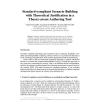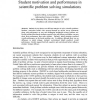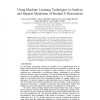AIED
2007
Springer
2007
Springer
Standard-Compliant Scenario Building with Theoretical Justification in a Theory-Aware Authoring Tool
14 years 5 months ago
Nowadays standard technologies play important roles in enhancing sharability, reusability and interoperability of learning contents. However, there is a lack of pedagogical justifi...
AIED
2007
Springer
14 years 5 months ago
2007
Springer
Razzaq and Heffernan (2006) showed that scaffolding compared to hints on demand in an intelligent tutoring system could lead to higher averages on a middle school mathematics post-...
AIED
2007
Springer
14 years 5 months ago
2007
Springer
AIED
2007
Springer
14 years 5 months ago
2007
Springer
One important aspect of motivation is engagement. In order to learn, students need to be engaged in the learning activities. However, that does not always happen due to various fac...
AIED
2007
Springer
14 years 5 months ago
2007
Springer
AIED
2007
Springer
14 years 5 months ago
2007
Springer
Students are starting to use networked visual argumentation tools to discuss, debate, and argue with one another about topics presented by a teacher. However, this development give...
AIED
2007
Springer
14 years 5 months ago
2007
Springer
The main goal of the work presented here is to allow for the broader dissemination of intelligent tutoring technology. To accomplish this goal, we have two clear objectives. First,...
AIED
2007
Springer
14 years 5 months ago
2007
Springer
In many intelligent tutoring systems, a detailed model of the task domain is constructed and used to provide students with assistance and direction. Reciprocal tutoring systems, h...
AIED
2007
Springer
14 years 5 months ago
2007
Springer
Adding student collaboration to an intelligent tutoring system could leverage the benefits of both approaches. We have incorporated a mutual peer tutoring script, where students of...
AIED
2007
Springer
14 years 5 months ago
2007
Springer
In this paper, we raise a methodological issue concerning the empirical analysis of tutoring dialogues: The frequencies of tutoring moves do not necessarily reveal their causal efï...




